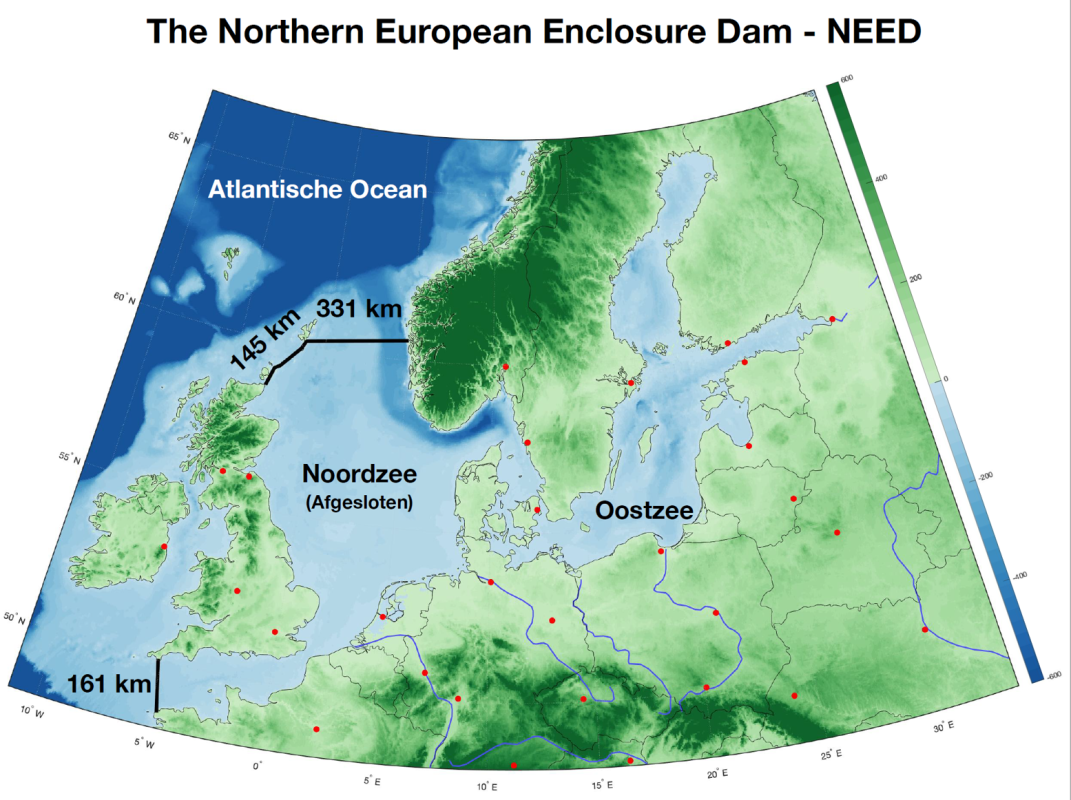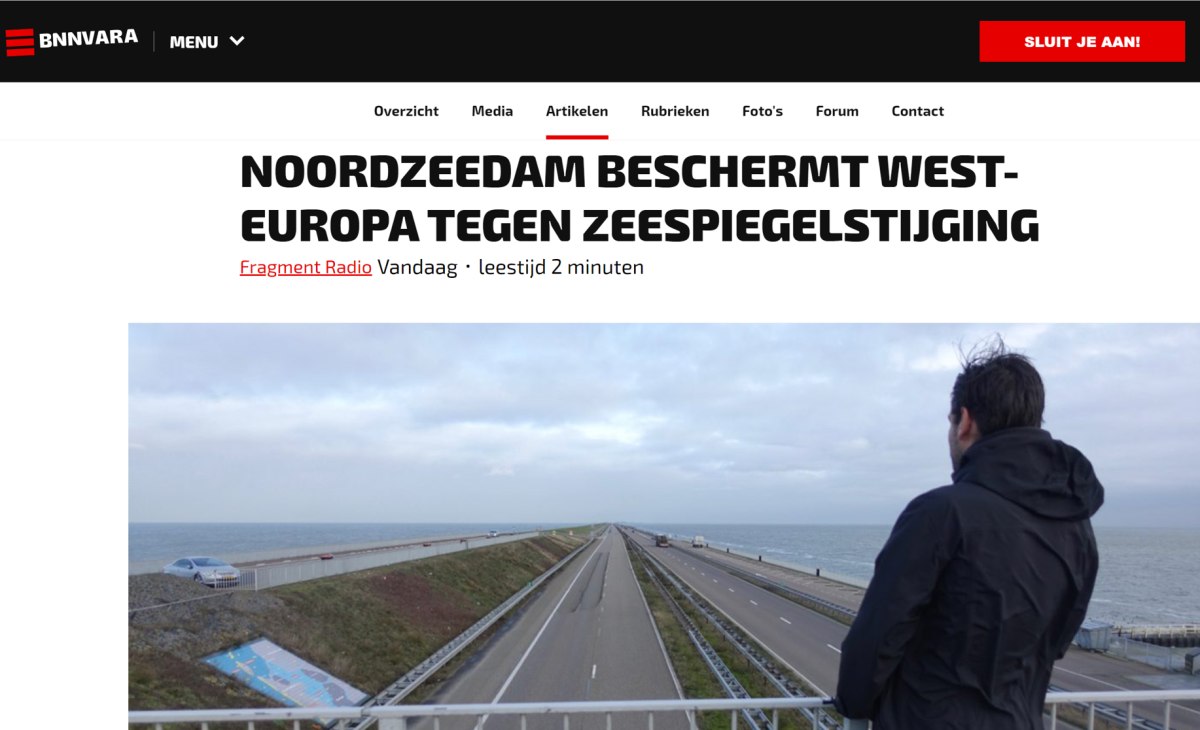Een dam dwars door de Noordzee: waarschuwscenario voor klimaatverandering
Dat schrijft dr. Sjoerd Groeskamp, oceanograaf aan het Koninklijk Nederlands Instituut voor Onderzoek der Zee, samen met zijn Zweedse collega Joakim Kjellson van GEOMAR in Kiel, Duitsland, in het wetenschappelijk tijdschrift “The Bulletin of the American Meterological Society” . ‘Behalve een mogelijke oplossing, is het ontwerp van zo’n extreme dam vooral een waarschuwing’, zegt Groeskamp. ‘Het laat zien hoe gigantisch het probleem is dat boven ons hoofd hangt.’
Technisch haalbaar
‘De bouw van zo’n “Noord-Europese Afsluitdijk” lijkt technisch haalbaar’, benadrukt Groeskamp. ‘De maximale diepte van de Noordzee tussen Frankijk en Engeland is net honderd meter. Tussen Schotland en Noorwegen is de gemiddelde diepte 127 meter, met een maximum van 321 meter vlak voor de kust van Noorwegen. We bouwen nu ook vaste boorplatforms op diepten van meer dan 500 meter, dus dan lijkt zo’n dam ook te doen.’
Economie en natuur
De gevolgen van deze dam voor de Noordzeenatuur zijn enorm, erkennen de auteurs. ‘In een groot deel van de Noordzee verdwijnt het getij en daarmee het transport van slib en voedingsstoffen. Uiteindelijk wordt het zelfs een zoet meer. De natuur en daarmee ook de visserij zal drastisch veranderen’, aldus Groeskamp.
‘De financiële kosten voor de aanleg van de dam hebben we geschat door extrapolatie van de kosten voor grote dammen in bijvoorbeeld Zuid-Korea. In de uiteindelijke rekensom moet je ook nog zaken als het verlies aan inkomsten uit de Noordzeevisserij meerekenen, net als de toegenomen kosten voor de scheepvaart over de Noordzee en ook de kosten om al het rivierwater dat nu in de Noordzee stroomt met gigantische pompen aan de andere kant van de dam te krijgen.’
Waarschuwing
Uiteindelijk is de schets van deze extreme dam eerder een waarschuwing, dan een oplossing, stelt Groeskamp. ‘De kosten en de consequenties van zo’n dam zijn inderdaad enorm. Maar wij hebben berekend dat de kosten van niets doen tegen zeespiegelstijging uiteindelijk nog veel hoger zullen zijn. Deze dam maakt bijna tastbaar wat de gevolgen zullen zijn van een zeespiegelstijging van – in de meest sombere scenario’s – 10 meter in het jaar 2500. Deze dam is dan ook vooral een pleidooi om nú iets te doen tegen de klimaatverandering. Als we niks doen, is deze extreme dam misschien de enige oplossing.’
A dam right across the North Sea
A defence against climate change, but primarily a warning
A 475-km-long dam between the north of Scotland and the west of Norway and another one of 160 km between the west point of France and the southwest of England could protect more than 25 million Europeans against the consequences of an expected sea level rise of several metres over the next few centuries. The costs, 250-500 billion euros, are “merely” 0.1% of the gross national product, annualy over 20 years, of all the countries that would be protected by such a dam. That’s what Dr Sjoerd Groeskamp, oceanographer at the Royal Netherlands Institute for Sea Research, calculated together with his Swedish colleague Joakim Kjellson at GEOMAR in Kiel, Germany, published this month in the scientific journal “The Bulletin of the American Meterological Society”. ‘Besides being a possible solution, the design of such an extreme dam is mainly a warning’, says Groeskamp. ‘It reveals the immensity of the problem hanging over our heads.’
Technically feasible
‘The construction of such a “North-European Enclosure Dam” seems to be technically feasible’, Groeskamp emphasises. ‘The maximum depth of the North Sea between France and England is scarcely one hundred metres. The average depth between Scotland and Norway is 127 metres, with a maximum of 321 metres just off the coast of Norway. We are currently able to build fixed platforms in depths exceeding 500 metres, so such a dam seems feasible too.’
Economy and wildlife
The authors acknowledge that the consequences of this dam for North Sea wildlife would be considerable. ‘The tide would disappear in a large part of the North Sea, and with it the transport of silt and nutrients. The sea would eventually even become a freshwater lake. That will drastically change the ecosystem and therefore have an impact on the fishing industry as well’, Groeskamp elaborates.
‘We estimated the financial costs for the construction of the dam by extrapolating the costs for large dams in South Korea, for example. In the final calculation, we must also take into account factors such as the loss of income from North Sea fishing, the increased costs for shipping across the North Sea and the costs of gigantic pumps to transport all of the river water that currently flows into the North Sea to the other side of the dam.’
Warning
Ultimately, the description of this extreme dam is more of a warning than a solution, Groeskamp states. ‘The costs and the consequences of such a dam are huge indeed. However, we have calculated that the cost of doing nothing against sea level rise will ultimately be many times higher. This dam makes it almost tangible what the consequences of the sea level rise will be; a sea level rise of 10 metres by the year 2500 according to the bleakest scenarios. This dam is therefore mainly a call to do something about climate change now. If we do nothing, then this extreme dam might just be the only solution.’
Article Early Online Release:
Sjoerd Groeskamp, Joakim Kjellsson. NEED The Northern European Enclosure Dam for if climate change mitigation fails. Bulletin of the American Meteorological Society. DOI 10.1175/BAMS-D-19-0145.1


- RTL nieuws Editie NL 11 feb
- RTLZ 11 feb: Megalomaan idee giga dijk Noordzee
- NRC: Honderd jaar bouwen aan een dijk rond de Noordzee
- The Guardian: Giant dams enclosing North Sea could protect millions from rising waters
- Volkskrant 24 feb: Klimaatplannen mislukt? ‘Dam dan de Noordzee in’
- New York Times 14 feb: As Sea Levels Rise, Scientists Offer a Bold Idea: Dam the North Sea